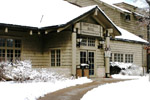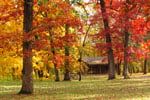ROCK CUT STATE PARK
Chiseled out of the state?s far northern region is Rock Cut State Park in Winnebego County. Nearby are other "rocky" landmarks - the mighty Rock River and the place where wagons once forded it, Rockford. It?s an area of rolling plains, interesting history and recreational variety.
Two lakes set off the park?s 3,092 acres. Pierce Lake, with 162 acres, is a retreat for people wanting to fish, ice fish or ice skate. A second 50-acre Olson Lake is especially for swimmers. Rounding out the park?s recreational options are camping, hiking, horseback trails and cross-country skiing. Whatever the season, you can be sure there?s quite a bit of activity going on at Rock Cut State Park.
Because water serves as a welcome mat to birds and animals, wildlife watchers to the area won?t be disappointed. Birders report good viewing, with waterfowl being abundant. Deer, fox, muskrat, woodchuck and beaver inhabit Rock Cut State Park as do opossum, raccoon and both gray and fox squirrel. Over 100 types of wildflowers offer a showy display each spring and summer, while the hardwood trees dazzle you with their reds and golds every fall.
By the middle of the 17th century, Miami-speaking tribes of Native Americans entered the region of Rock Cut State Park after the Iroquois drove them from territory on the southern end of Lake Michigan. From about 1655 until 1735, the Rock River was within the range of the Mascouten, who were also pushed westward by the Iroquois. The Winnebago ranged southward from Wisconsin to the Rock River from the 1740s until 1837, while the river?s upper portion was on the periphery of the Fox and Sauk territory from about 1765 to 1833. By 1800, the Potawatomi, Ottawa and Chippewa nations had extended their range into the area, but they ceded their lands to the United States 32 years later following the Black Hawk War.
Settlement of Winnebago County Began after the Black Hawk War. The region that is now Rock Cut State Park was settled partly by Scots around Argyle - named for their Scottish home of Argyllshire - and partly by Canadians, New Yorkers and New Englanders around the town of Harlem - named for New York City?s Harlem. The Illinois version of Harlem was moved in 1859 when the Kenosha-Rockford Rail Line was built. The dammed waters of Pierce Lake now cover much of the railroad bed within the park, although portions of the railroad grade are visible along Willow Creek below the spillway. But blasting operations in a rock outcrop that railroad crews conducted during the 1859 construction left lasting impressions here - they cut through rock to provide a suitable roadbed and gave Rock Cut its name.
The Park's Present:
Because water serves as a welcome mat to birds and animals, wildlife watchers to the area won?t be disappointed. Birders report good viewing, with waterfowl being abundant. Deer, fox, muskrat, woodchuck and beaver inhabit Rock Cut State Park as do opossum, raccoon and both gray and fox squirrel. Over 100 types of wildflowers offer a showy display each spring and summer, while the hardwood trees dazzle you with their reds and golds every fall.
Day-UseFishingyes
Hiking Trailyes
Swimming Beachyes
Bridle Trailsyes
CampingPrimitiveyes
Electric Sitesyes
WinterActivitiesyes
For those who want to include an overnight stay in their visit to Rock Cut, the park offers 28 Class A-Premium sites for reservation, 180 Class A-Premium sites and 60 Class B-Premium sites on a first-come first-serve basis. There is also a primitive cabin available for reservation. It has electricity, but does not have water or plumbing facilities.
Open year round, the campgrounds provide water, electricity, sanitary dump stations, showers, toilets, a boat launch and playground equipment. Only electricity and pit toilets are available in the winter season. Equestrian camping is restricted to a site on Hart Road. Groups of more than 25 persons need advance permission from the site superintendent before they can enter the park, and all campers require a permit from park personnel. Alcohol is prohibited in the campground.
Olson Lake Beach will be operated this summer (Memorial Day weekend to Labor Day weekend) by contract of Beachwatch Lifeguard & Lake Patrol. The Beach is open from 12:00PM to 7:00PM daily, weather permitting. Amenities include Lifeguards, sand volleyball courts, paddle boat rentals, concession items and a changing room. The cost is $3 per person. For additional information call 815/978-5560.
Enjoy fishing in two large lakes, Pierce Lake and Olson Lake. Species include bluegill, largemouth bass, channel catfish and muskie. Ice-fishing is available during winter months on Pierce lake only. A valid Illinois Fishing License is required for those aged 16 or older.





